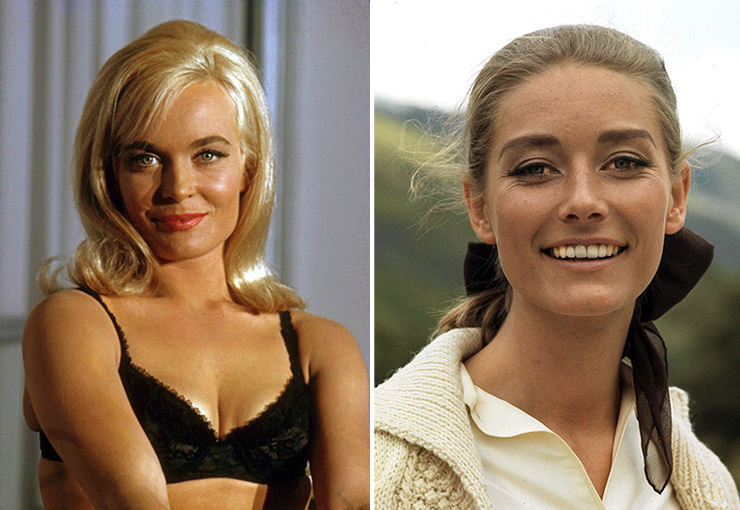 |
|
On January 9, 1964 it was
announced in the UK press that Honor Blackman had been cast as Pussy
Galore; then starring opposite
Patrick Macnee in the popular ITV series
The Avengers, her casting was front page news in the UK, although
shortly before filming began on Goldfinger there was still some
debate whether the name Pussy Galore would be used, and changing it to
‘Kitty Galore’ may avoid any censorship problems in certain territories.
All worries the producers had over using Fleming’s risqué name for the
heroine of Goldfinger were quashed following Blackman’s meeting
with HRH Prince Philip, The Duke of Edinburgh at the premiere of the Doris
Day comedy Move Over Darling (1964) at London’s ODEON Leicester
Square on Monday, February 24, 1964. The meeting was reported by film
critic Barry Norman with a front page photo in the next day’s Daily
Mail under the headline “Pussy and the Prince” – if it was acceptable
to British royalty the rest of the world would follow suit! English model
Tania Mallet secured the role of Tilly Masterson, after testing for the
role of Tatiana Romanova in From Russia With Love a year earlier;
and Albert R. Broccoli was also convinced he had found the perfect
Goldfinger following tests with German actor Gert Frobe in early January
1964. However, Frobe spoke little English and had learned his lines
phonetically. When it was discovered that Frobe’s voice was unsuitable for
use in the film he was later expertly re-voiced by English actor
Michael
Collins (1921-1979), although throughout filming
Monica “Nikki” van der
Zyl (1935-2021) acted as Frobe’s on-set dialogue coach. Nikki van der Zyl
would herself also re-voice Shirley Eaton and Nadja Regin in Goldfinger
(1964), and continued to do so with other actresses in the James Bond
series until 1979. With the main cast assembled and a script finally
polished, only one component was missing… Sean Connery. |
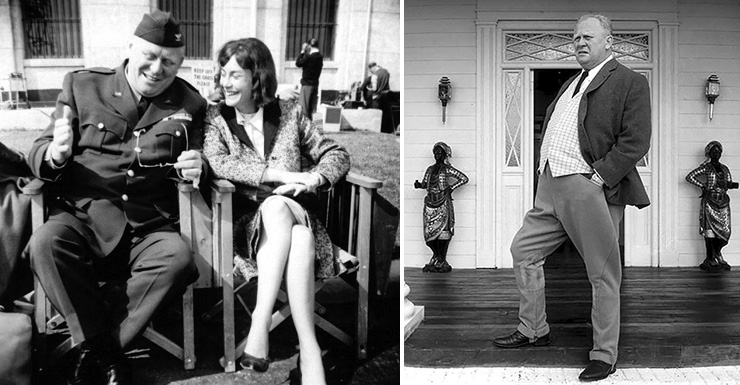 |
|
ABOVE: (left)
Although he was ultimately re-voiced by Michael Collins, Nikki van
der Zyl [pictured in front of the Fort Knox set at Pinewood
Studios with Frobe] acted as Gert Frobe's on-set vocal coach
during the filming of Goldfinger (1964). (right) Gert Frobe
on Ken Adam's impressive exterior set for Goldfinger's Kentucky
home, also constructed on the Pinewood backlot. |
|
|
|
Following his success in
the first two James Bond films, which were filmed back-to-back, Sean
Connery then made Woman of Straw (1964) opposite Italian star Gina
Lollobrigida (1927-2023), and at that time was currently finishing
production as the lead in Alfred Hitchcock’s Marnie (1964) in
Hollywood. Despite still being contracted to EON Productions, Connery
began to flex his film star muscles, and insisted on a higher salary for
Goldfinger when he saw what the producers were making following the
runaway success of the first two James Bond films. Although announced as
starring in Goldfinger, Connery told film critic Barry Norman in a
report that appeared in the Daily Mail on February 8, 1964 that he
had not yet agreed terms with the producers – going on to say: “I don’t
want to go into details but it concerns my artistic control of the
picture.”…adding “nothing is settled, as far as I am concerned.”
Albert R. Broccoli had flown to Los Angeles with screenwriter Richard
Maibaum to meet with Connery to discuss details regarding the screenplay,
and at a meeting on February 3, 1964 the trio addressed the actors
concerns over his character and tone of the script. Production on
Goldfinger had begun on January 20, 1964 in Miami with Guy Hamilton,
Harry Saltzman, and Production Designer
Ken Adam; with cinematographer Ted
Moore and a small unit filming at the Fontainebleau Hotel, and at an auto
‘graveyard’ for the scene where the deceased gangster Mr. Solo (Martin
Benson) is crushed in a 1964 Lincoln Continental limousine. |
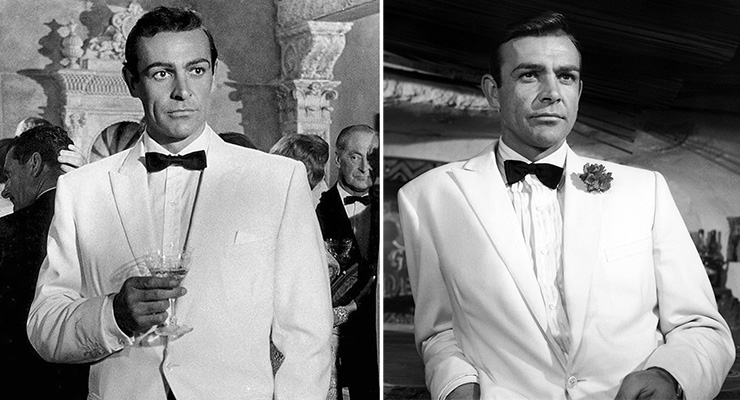 |
|
ABOVE: (left) Sean
Connery in Woman of Straw (1964), filmed at Pinewood
Studios directly after he finished work on From Russia With
Love (1963). Six of the suits tailored by Anthony Sinclair
worn by Sean Connery in Woman of Straw were then acquired
for the production of Goldfinger (1964), and Connery wears
the identical white tuxedo (right) in the pre-credit sequence. The
publicity still from Woman of Straw is frequently
misidentified as an image from Goldfinger.
BELOW: In Woman of Straw (1964) Sean Connery's character of
playboy Anthony Richards wears a white monogrammed bathrobe that
was also acquired by the Goldfinger production; the actor
is seen here wearing the bathrobe during breakfast with Shirley
Eaton in Pinewood’s Mansion restaurant. |
|
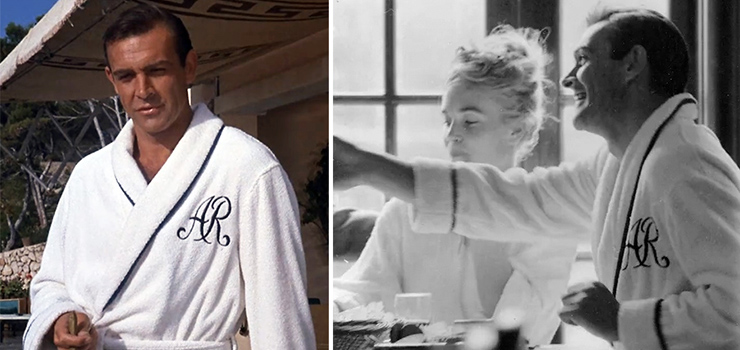 |
|
|
Back in the UK Richard
Maibaum and Paul Dehn worked together on revising the script to
incorporate some of Sean Connery’s comments, and a new fourth and final
draft was delivered on February 26, 1964. Filming on Goldfinger
began at Pinewood Studios on March 9, 1964 – still without Sean Connery
who was finishing Marnie in Hollywood – and included night scenes
of the Aston Martin DB5 careering around the studio driveways standing in
as Goldfinger’s Swiss factory ‘Auric Enterprises’, and some scenes from
the pre-credit sequence involving stuntman
Alf Joint as Mexican assassin Capungo. Clearly, Sean Connery did eventually agree terms with the
producers and arrived on set on March 19, 1964 to complete the fight scene
with Alf Joint. Film critic Barry Norman reported in the Daily Mail
on May 8, 1964 that Sean Connery was now a member of a group of British
actors who could command more than £100,000 for a film performance. Until
this point Peter Sellers was the only British actor receiving such a sum
for his films. Connery commented to Barry Norman: “I’ve a contract to
do three more Bond pictures in the next 3½ years and I’m perfectly happy
about it. It gives me the security for that time and also leaves me free
to make other films for a great deal of money.” In reality the
£100,000 was a bonus payment in US dollars (then equivalent to £35,714) in
addition to the £22,500 salary he received. Connery’s agent Richard Hatton
also negotiated 5% of the net profits of Goldfinger. Although the
producers each received a similar up-front payment, they started out with
50% of the net profits, which had increased to 60% by the time of
Goldfinger. Despite his contentment in 1964, Sean Connery would become
less happy with his remuneration in relation to what the producers were
making off him, and this led to further tension and re-negotiations
between them in the following years. Connery had been paid £6,000 for his
first appearance in Dr. No in 1962, followed by a fee of £24,325
for From Russia With Love (1963). |
|
|
|
The first scenes to be
shot between Sean Connery and Gert Frobe were on Ken Adam’s impressive
laser room set on ‘E’ Stage at Pinewood Studios.
John Stears’ special
effects team, which included
Frank George, Jimmy Ward,
Joe Fitt,
Bert Luxford (practical effects), and
Cliff Culley (optical effects), skilfully
co-ordinated the complex scene incorporating several different elements to
achieve the finished sequence. Studio work continued with Shirley Eaton
and Sean Connery filming their introductory balcony scene on Pinewood’s
‘D’ Stage on March 23-24, just a week after Eaton was hired for the role
of Jill Masterson. The scene was re-shot several times, with their love
scenes filmed on April 6th. Two weeks later on April 20, 1964 Shirley
Eaton was painted gold for her iconic death scene. A stills session in
Pinewood’s ‘Pool Studio’ with American photographer
Loomis Dean featured
Shirley (painted gold a second time) on the cover of LIFE Magazine
to promote Goldfinger in the USA in November 1964. Shirley Eaton
fought for, and received, an ‘also starring’ credit on the US posters and
undertook a Stateside promotional tour in December 1964. Her name was also
later added to subsequent re-issue posters and advertising materials in
the UK. Author Ian Fleming
visited the set at Pinewood Studios during the filming of the scenes
between Sean Connery and Shirley Eaton on the Miami Beach Fontainebleau
Hotel set. Within six months the James Bond author was dead at the age of
56. Although Ian Fleming had finally begun to reap the financial rewards he
had longed for from his fictional secret agent, he did not live long
enough to see the phenomenal worldwide success the third James Bond film
would become following its UK release in September 1964. |
|
|
|
CONTINUED >> |
|
|
LIMITED NUMBERS LEFT IN STOCK!
The 007 MAGAZINE ‘GOLDFINGER portfolio’ steelbook
350-page Wiro Bound Numbered Limited Edition |
|
|
The ‘GOLDFINGER portfolio’ is a 350-page metal covered celebration
of everything that is representative of this great film and is packed with
over 1,000 images from the 007 MAGAZINE ARCHIVE with detailed
informational photo captions throughout, and also includes: |
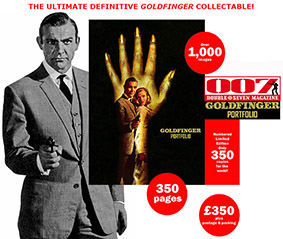 |
|
• |
Call Sheets |
|
• |
Documents |
|
• |
Press Releases |
|
• |
Blueprints |
|
• |
Ken Adam Sketches |
|
• |
Press Ads |
|
• |
Contact Sheets |
|
• |
UK
Front of House sets |
|
• |
Complete UK Exhibitors’ Campaign Book |
|
• |
Many
never-before-seen images
– including two scenes shot but cut
from the film and featured here for the first time anywhere!
|
| |
| |
SEE FULL DETAILS |
|
UK GBP
£350 + P&P |
USA USD
$550 + P&P |
Western Europe
Euro €437 + P&P |
Eastern Europe
Euro €437 + P&P |
Rest of World
(including Australia, New Zealand, Canada & Far East) GBP £350 + P&P |
|
|
|
|
|
|
|
|
|
|

